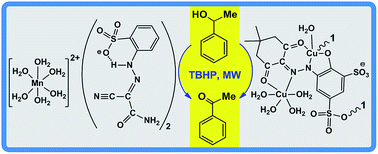MnII and CuII complexes with arylhydrazones of active methylene compounds as effective heterogeneous catalysts for solvent- and additive-free microwave-assisted peroxidative oxidation of alcohols†
Abstract
A one-pot template reaction of sodium 2-(2-(dicyanomethylene)hydrazinyl)benzenesulfonate (NaHL1) with water and manganese(II) acetate tetrahydrate led to the mononuclear complex [Mn(H2O)6](HL1a)2·4H2O (1), where (HL1a)− = 2-(SO3−)C6H4(NH)N![[double bond, length as m-dash]](https://www.rsc.org/images/entities/char_e001.gif) C(C
C(C![[triple bond, length as m-dash]](https://www.rsc.org/images/entities/char_e002.gif) N) (CONH2) is the carboxamide species derived from nucleophilic attack of water on a cyano group of (HL1)−. The copper tetramer [Cu4(H2O)10(1κN:κ2O:κO,2κN:κO-L2)2]·2H2O (2) was obtained from reaction of Cu(NO3)2·2.5H2O with sodium 5-(2-(4,4-dimethyl-2,6-dioxocyclohexylidene)hydrazinyl)-4-hydroxybenzene-1,3-disulfonate (Na2H2L2). Both complexes were characterized by elemental analysis, IR spectroscopy, ESI-MS and single crystal X-ray diffraction. They exhibit a high catalytic activity for the solvent- and additive-free microwave (MW) assisted oxidation of primary and secondary alcohols with tert-butylhydroperoxide, leading to yields of the oxidized products up to 85.5% and TOFs up to 1.90 × 103 h−1 after 1 h under low power (5–10 W) MW irradiation. Moreover, the heterogeneous catalysts are easily recovered and reused, at least for three consecutive cycles, maintaining 89% of the initial activity and a high selectivity.
N) (CONH2) is the carboxamide species derived from nucleophilic attack of water on a cyano group of (HL1)−. The copper tetramer [Cu4(H2O)10(1κN:κ2O:κO,2κN:κO-L2)2]·2H2O (2) was obtained from reaction of Cu(NO3)2·2.5H2O with sodium 5-(2-(4,4-dimethyl-2,6-dioxocyclohexylidene)hydrazinyl)-4-hydroxybenzene-1,3-disulfonate (Na2H2L2). Both complexes were characterized by elemental analysis, IR spectroscopy, ESI-MS and single crystal X-ray diffraction. They exhibit a high catalytic activity for the solvent- and additive-free microwave (MW) assisted oxidation of primary and secondary alcohols with tert-butylhydroperoxide, leading to yields of the oxidized products up to 85.5% and TOFs up to 1.90 × 103 h−1 after 1 h under low power (5–10 W) MW irradiation. Moreover, the heterogeneous catalysts are easily recovered and reused, at least for three consecutive cycles, maintaining 89% of the initial activity and a high selectivity.


 Please wait while we load your content...
Please wait while we load your content...